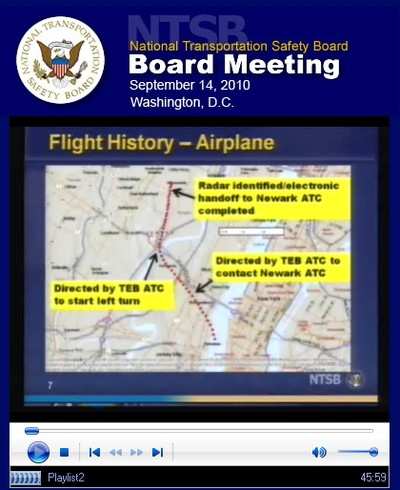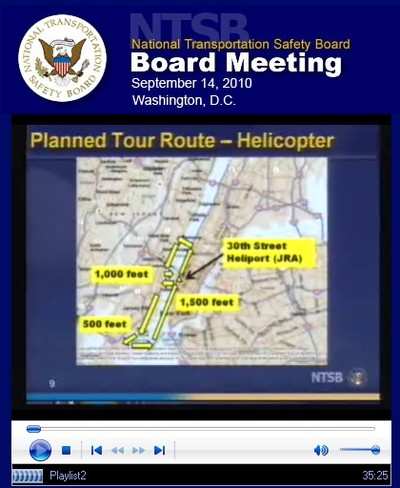Tue, Sep 14, 2010
Pilots, Controller, FAA All Cited As Contributing To The
Accident
 The NTSB took about five hours
Tuesday to come to a determination of probable cause in the
accident last year over the Hudson River that fatally injured
nine people, and sparked major changes in air space rules in the
popular VFR corridor. The ruling could be seen as calling into
question the entire concept of "see and avoid" for maintaining
separation between VFR aircraft.
The NTSB took about five hours
Tuesday to come to a determination of probable cause in the
accident last year over the Hudson River that fatally injured
nine people, and sparked major changes in air space rules in the
popular VFR corridor. The ruling could be seen as calling into
question the entire concept of "see and avoid" for maintaining
separation between VFR aircraft.
During the hearing, which was presented online via streaming
video, witnesses recounted the events that led up to the August
8th, 2009 accident in which a Piper PA-32R-300 (N71MC) with three
people on board collided with a Eurocopter AS 350 BA (N401LH)
carrying five passengers on a sightseeing tour. The helicopter was
determined to be about 100 feet above its planned altitude of 1,000
feet when it collided with the Saratoga. The New York
Times reports that witnesses before the Board said that it was
likely that the Piper pilot could have seen the helicopter, but
that it would have been difficult to discern against the Manhattan
skyline until just a few seconds before the collision. The
approaching Saratoga would have been over the right shoulder of the
Eurocopter pilot, so he would not have been likely to see the
aircraft coming, according to those testifying before the
Board.
Both aircraft were TIS equipped, and a failure of the pilots to
use that traffic avoidance information was cited as a contributing
factor in the accident. The FAA is also named for what the board
called "inadequate" communications procedures and vertical
separation rules in the Hudson River corridor.

But as far as "probable cause" is concerned, the NTSB cited the
"inherent limitations" of 'see and avoid', as well as the actions
of the air traffic controller working the flight from Teterboro.
The controller was reportedly distracted by a personal phone call
while on duty. The Saratoga pilot reportedly read back an incorrect
frequency change instruction on the handoff to Newark Liberty
Airport ATC, which made it so that ATC was unable to contact the
Saratoga to warn that pilot of the impending collision.

The board voted 3-1, with one abstention, that "The NTSB
determines that the probable cause of this accident was the
inherent limitations of the "see and avoid" concept, which made it
difficult for the airplane pilot to see the helicopter until the
final seconds before the collision, and the Teterboro airport local
controllers' non-pertinent telephone conversation which distracted
him from his air traffic control duties including correcting the
airplane pilot's readback of the incorrect frequency, and the
timely transfer of communications for the accident airplane to the
Newark Liberty airport tower. Contributing to the accident were 1)
both pilots ineffective use of available information from the
aircraft's electronic traffic advisory system to maintain awareness
of nearby traffic. 2) Inadequate FAA procedures for transfer of
communication among ATC facilities near the Hudson River Class B
exclusion zone, and 3) FAA regulations that did not provide
adequate vertical separation for aircraft operating in the Hudson
River Class B exclusion zone."
More News
DETRESFA (Distress Phrase) The code word used to designate an emergency phase wherein there is reasonable certainty that an aircraft and its occupants are threatened by grave and i>[...]
Aero Linx: The International Association of Missionary Aviation (IAMA) The International Association of Missionary Aviation (IAMA) is comprised of Mission organizations, flight sch>[...]
Also: EP Systems' Battery, Boeing SAF, Repeat TBM 960 Order, Japan Coast Guard H225 Buy Despite nearly 100 complaints totaling millions of dollars of potential fraud, combined with>[...]
Also: Viasat-uAvionix, UL94 Fuel Investigation, AF Materiel Command, NTSB Safety Alert Norges Luftsportforbund chose Aura Aero's little 2-seater in electric trim for their next gli>[...]
Also: Moya Delivery Drone, USMC Drone Pilot, Inversion RAY Reentry Vehicle, RapidFlight UAVOS has recently achieved a significant milestone in public safety and emergency services >[...]
 ANN's Daily Aero-Term (04.26.24): DETRESFA (Distress Phrase)
ANN's Daily Aero-Term (04.26.24): DETRESFA (Distress Phrase) ANN's Daily Aero-Linx (04.26.24)
ANN's Daily Aero-Linx (04.26.24) Airborne 04.22.24: Rotor X Worsens, Airport Fees 4 FNB?, USMC Drone Pilot
Airborne 04.22.24: Rotor X Worsens, Airport Fees 4 FNB?, USMC Drone Pilot Airborne 04.24.24: INTEGRAL E, Elixir USA, M700 RVSM
Airborne 04.24.24: INTEGRAL E, Elixir USA, M700 RVSM Airborne-NextGen 04.23.24: UAVOS UVH 170, magni650 Engine, World eVTOL Directory
Airborne-NextGen 04.23.24: UAVOS UVH 170, magni650 Engine, World eVTOL Directory





